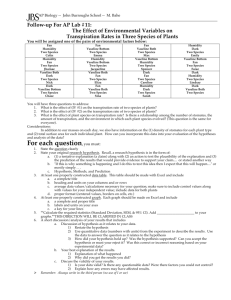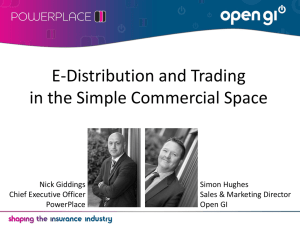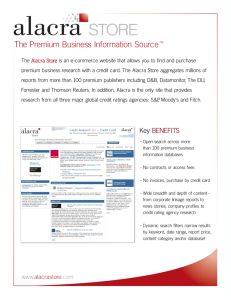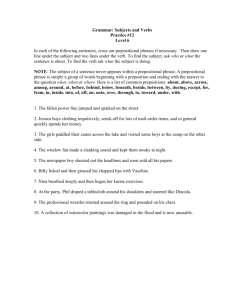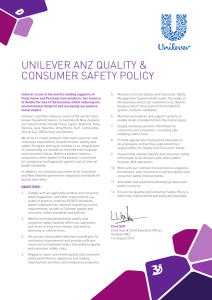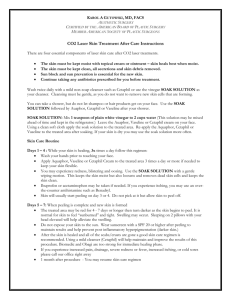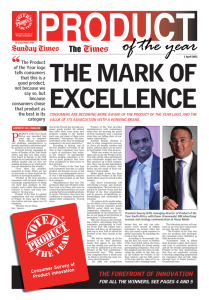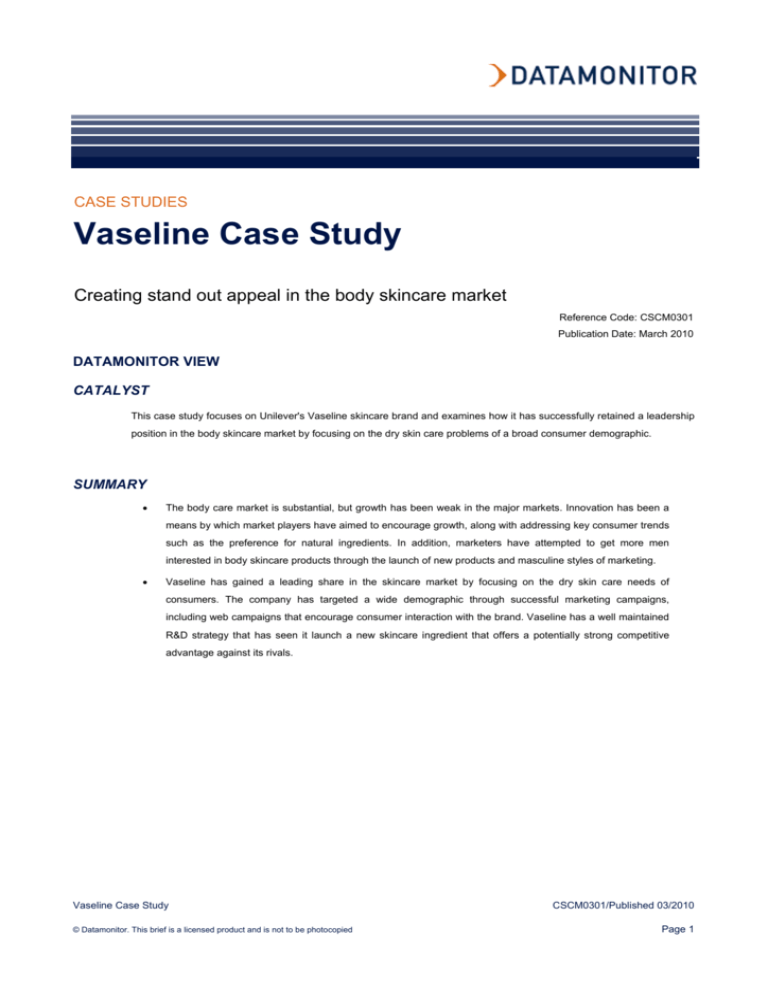
CASE STUDIES
Vaseline Case Study
Creating stand out appeal in the body skincare market
Reference Code: CSCM0301
Publication Date: March 2010
DATAMONITOR VIEW
CATALYST
This case study focuses on Unilever's Vaseline skincare brand and examines how it has successfully retained a leadership
position in the body skincare market by focusing on the dry skin care problems of a broad consumer demographic.
SUMMARY
•
The body care market is substantial, but growth has been weak in the major markets. Innovation has been a
means by which market players have aimed to encourage growth, along with addressing key consumer trends
such as the preference for natural ingredients. In addition, marketers have attempted to get more men
interested in body skincare products through the launch of new products and masculine styles of marketing.
•
Vaseline has gained a leading share in the skincare market by focusing on the dry skin care needs of
consumers. The company has targeted a wide demographic through successful marketing campaigns,
including web campaigns that encourage consumer interaction with the brand. Vaseline has a well maintained
R&D strategy that has seen it launch a new skincare ingredient that offers a potentially strong competitive
advantage against its rivals.
Vaseline Case Study
© Datamonitor. This brief is a licensed product and is not to be photocopied
CSCM0301/Published 03/2010
Page 1
Vaseline Case Study
ANALYSIS
Setting the scene: market overview
The body care market is substantially sized, but growth is small
The global body care market was worth $11.7 billion in 2009, with Europe being the strongest market, at $4.8 billion in that
year (see Table 1). Growth is forecast to be fairly small in the 2009 to 2013 period, with the US market forecast to have a
compound annual growth rate (CAGR) of only 1.3%. Europe is forecast to have the strongest regional growth, at 4.8%,
indicating that this region will continue to be the largest for body care in the near future.
The leading global brands in body care are Nivea (owned by Beiersdorf), Unilever's Dove, and Clarins. According to
Datamonitor's Market Data Analytics (see Table 2), Nivea has a substantial leading share of the market (13.4%), way
ahead of the joint second brands (3.7% each). Nivea produces a range of body care brands that offer moisturization
benefits as well as anti-aging properties, toning creams and a men's lotion. Competitors such as Unilever will therefore
have to work hard to make an impact on Beiersdorf's global share.
Table 1:
Body care market size, $m, 2004–13
Body care
2004
Europe
3,649
4,792
5,781
5.6%
4.8%
Asia Pacific
3,000
3,656
4,174
4.0%
3.4%
US
1,612
1,808
1,905
2.5%
1.3%
Global
9,398
11,689
13,547
4.5%
3.8%
Source: Datamonitor's Market Data Analytics
Vaseline Case Study
© Datamonitor. This brief is a licensed product and is not to be photocopied
2009
2013
2004–09
2009–13
DATAMONITOR
CSCM0301/Published 03/2010
Page 2
Vaseline Case Study
Table 2:
Leading brands in the global body care, 2008
Company
Brand
2008
Beiersdorf AG
Nivea
13.4%
Unilever
Dove
3.7%
Clarins SA
Clarins
3.7%
Shiseido Company, Ltd
Inicio
3.4%
Unilever
Vaseline
3.0%
Kracie Holdings, Ltd
Exercise
2.9%
L'Oreal S.A.
Lancôme
2.8%
Estée Lauder Companies Inc., The
Clinique
2.3%
Johnson & Johnson
Johnson's
2.2%
Shiseido Company, Ltd
Hadasui 1
1.5%
Procter & Gamble Company, The
Olay
1.5%
Johnson & Johnson
Neutrogena
1.5%
Source: Datamonitor's Market Data Analytics
DATAMONITOR
Body care has been boosted by the natural trend
While body care growth has been fairly low recently, marketers are looking to the natural trend to attempt to boost the
market, a trend which has gained consumer appeal due to its supposed health benefits, to the consumer and the
environment. Datamonitor's new product database, Product Launch Analytics, recorded that 'natural' and 'organic' were two
of the most popular claims in new body care launches in Europe and North America in the 2007–09 period. Some recent
product launches that emphasize a natural positioning are shown in Figure 1. In terms of popular fragrances used in body
care products over this period, marketers have stuck to traditional favorites, with floral and herbal scents being popular,
which again aligns well with the natural trend. Leading ingredients, meanwhile, include glycerin which has been used for
many years as a moisturizing agent. Shea butter is also a popular ingredient, benefiting from the popularity of the natural
trend as it is sourced directly from the African shea tree (see Table 3).
Table 3:
Leading fragrances, claims and ingredients in new body care launches in Europe and North
America, 2007–09
Fragrances
Claims
Ingredients
Vanilla
Upscale
Glycerin
Lavender
Natural
Water
Rose
Women
Fragrance
Jasmine
High vitamins
Shea butter
Floral
Organic
Methylparaben
Source: Datamonitor's Product Launch Analytics
Vaseline Case Study
© Datamonitor. This brief is a licensed product and is not to be photocopied
DATAMONITOR
CSCM0301/Published 03/2010
Page 3
Vaseline Case Study
Figure 1:
Body skin creams that have a natural based formula include the following recent launches
The Eco.Kid Organics for Kids line is The Treat skincare line, available in the US
available in the US from Koenig & from Treat Beauty, includes Organic Sweet
Company, Inc. The line, including Hypo- Cream Double Churn Body Cream in a
Allergenic Body Lotion, is said to be made Pomegranate CoffeeBerry variety. It is
with wild-harvested botanicals.
made with certified organic ingredients,
including "nature's most powerful age
fighting superfruits pomegranate and coffee
berry."
Organic Essence Pure Organic Shea Cream
Hands & Bodies by Organic Essence is said
to be made with a high content of nonsaponifiable fatty acids and to contain no
solvents or chemicals. The line includes
Grapefruit, Lavender, Lemongrass, and
Vanilla Orange scents, along with a "baby
gentle and safe" Fragrance Free formula.
Source: Datamonitor's Product Launch Analytics
DATAMONITOR
Marketers have attempted to encourage more men to enter the body care market
It comes as little surprise to find that women dominate the body care market, given their overall preference for personal
care products. As Table 4 shows, women accounted for a substantial 88% of the global body care market in 2006.
Datamonitor's 2009 consumer survey found that women respondents were more likely than men to apply body skin creams
frequently. Nearly half of women globally said they applied it once a day or more, while nearly 60% of men said they used it
only on special occasions or never (see Figure 2). In addition, women tend to be more brand conscious than men about
which body skin creams they use. Over a third of women globally said they were quality conscious and careful about brand
selection, compared to just 17% of male respondents (see Figure 3). For this reason, therefore, the body care market has
tended to focus on the needs of women consumers.
However, marketers are attempting to attract more men to the body care market with new products designed especially for
male consumers; an increasing acceptance of facial products among men has been a key driver of this. However, they
have a hard task before them in boosting male interest in these products, mainly due to men's perceptions of masculinity
(with soft skin often seen as feminine) and body lotions therefore being perceived as inappropriate for male use.
Table 4:
The global body care market by gender, 2006
Gender
Market
Share of market, 2006*
Female
Body care
88%
Male
Body care
12%
*Year data were last available
Source: Datamonitor's Market Data Analytics
Vaseline Case Study
© Datamonitor. This brief is a licensed product and is not to be photocopied
DATAMONITOR
CSCM0301/Published 03/2010
Page 4
Vaseline Case Study
Figure 2:
Women apply body care products more often than men
QUESTION: How frequently do you use/apply the following beauty products and services?
Body skin creams
% of respondents
100%
90%
80%
70%
60%
50%
40%
30%
20%
10%
0%
14.0%
66.4%
18.3%
15.3%
29.5%
62.4%
56.5%
19.1%
36.4%
48.2%
Male
Female
Male
US
59.3%
33.4%
20.1%
49.9%
20.7%
18.4%
15.4%
16.7%
Female
Male
Europe
Female
Global
Countryor never
Only on special occasions
Every other day or a couple of times a week
One to three times a day or more
Source: Datamonitor
Figure 3:
DATAMONITOR
Many men do not use body skin creams
% of respondents
QUESTION: Which of these statements best reflects your outlook on the following products
or services? Body skin creams
100%
90%
80%
70%
60%
50%
40%
30%
20%
10%
0%
9%
13%
48%
43%
18%
7%
10%
38%
40%
11%
35%
Male
Female
US
44%
15%
37%
30%
17%
11%
11%
38%
30%
27%
23%
8%
11%
Male
Female
Europe
Male
Female
Global
Country
I don’t use these products
I am relatively indifferent about quality and am not concerned about which
brand I buy
I am quality conscious but don't pay much attention to which brand I
choose
I am quality conscious and careful about my brand selection
Source: Datamonitor Consumer Survey, May 2009
Vaseline Case Study
© Datamonitor. This brief is a licensed product and is not to be photocopied
DATAMONITOR
CSCM0301/Published 03/2010
Page 5
Vaseline Case Study
Brand focus: Vaseline
Overview
Vaseline is one of the most recognizable skincare brands in the world, gaining a strong customer base by focusing on the
th
body moisturizing needs of consumers. The brand, founded in the 19 century and now owned by Unilever, encompasses
a range of body moisturizing products, as well as other products such as deodorant, lip therapy and shower gels. The
following will focus on its body care offerings and how the company seeks to retain its leading position through new product
development and marketing initiatives.
Figure 4:
Key facts
Source: Datamonitor analysis
Figure 5:
DATAMONITOR
Vaseline timeline
Source: Datamonitor analysis
Vaseline Case Study
© Datamonitor. This brief is a licensed product and is not to be photocopied
DATAMONITOR
CSCM0301/Published 03/2010
Page 6
Vaseline Case Study
Figure 6:
The Vaseline line encompasses a large range of skin creams, some of which are shown below
Source: Datamonitor's Product Launch Analytics
Figure 7:
DATAMONITOR
SWOT Analysis
Strengths
Opportunities
Globally recognized, well established brand
Build prestige brands which have higher growth
potential
Successful focus on the buoyant dry skin
market
Concentrate on R&D operations to bring out frequent
NPD
Weaknesses
Threats
Lack of specific anti-aging products
Intense competition
Over focus on masstige market
The downturn impacting consumer skincare
purchases
Petroleum basis of main product is
considered by some consumers to be nonenvironmentally friendly and a skin pore
clogging agent
Source: Datamonitor analysis
DATAMONITOR
Vaseline has gained a leading share in the skincare market by focusing on consumers' dry skin problems
With over 100 years of experience on the skincare market, Vaseline has gained a strong customer following in body care.
As shown in Table 2, Vaseline is the fifth leading global brand for body care. Its popularity varies around the world, but in
general remains in a strong position. In its US home market, where the brand was born, Vaseline is the leading brand, with
a 7% share. It is less successful in Europe, being just outside the top 10 leading brands, while in Asia Pacific it features
inside the top 25 leading body care brands.
Vaseline Case Study
© Datamonitor. This brief is a licensed product and is not to be photocopied
CSCM0301/Published 03/2010
Page 7
Vaseline Case Study
Unilever focuses the Vaseline brand on dry skin, a market that has experienced strong growth due to the increasing
number of people who believe they have dry skin and want to try to get rid of it. There is no definite answer to how many
people suffer from dry skin, as the exact definition of this can vary from mild dryness to eczema. However, Unilever has
estimated that over 40% of women in the UK suffer from dry skin. If it can be assumed that there are similar proportions of
people with dry skin in other countries, this gives the company a significant market to target.
Unilever has commented that it believes sufferers of dry skin have a greater propensity to use body skincare products than
average consumers. Julie McCleave, Skincare Senior Category Manager at Unilever UK, noted that consumers with dry
skin "shop for the skincare fixture more regularly and have 25% more usage occasions than the average consumer, so they
equate to a huge market opportunity," (as quoted by Talking Retail, 2008). By focusing on dry skin, Vaseline is therefore
targeting regular skincare users who could be loyal to its products for years to come.
Datamonitor's 2008 consumer survey highlighted the fact that there is a potentially strong market for dry skin relieving
products. Over half of females and nearly a quarter of males globally polled said they are concerned and actively seeking
skincare products to address skin dryness, and could be targeted effectively by market players such as Vaseline (see
Figure 8).
Figure 8:
Skin dryness impacts a significant proportion of consumers
% of respo nd ents
QUESTION: How much of a concern are the following issues relating to skincare for you?
Skin dryness
100%
90%
80%
70%
60%
50%
40%
30%
20%
10%
0%
30.0 %
52.1 %
37 .1%
5 8.9%
17.7 %
28.0 %
27.7%
2 1.8%
F emale
50.7 %
44 .4%
23.9%
1 9.3%
Male
21.0 %
18 .4%
19.9 %
52.2 %
28.3 %
48.4%
Male
US
I am not concerned about this
Female
Male
Europe
F emale
Global
Co untr y
I am concerned about this BUT I don’t use products to address this issue
I am concerned about this AND actively use skincare products
Source: Datamonitor Consumer Survey, August 2008
Vaseline Case Study
© Datamonitor. This brief is a licensed product and is not to be photocopied
DATAMONITOR
CSCM0301/Published 03/2010
Page 8
Vaseline Case Study
The brand is marketed to a wide demographic, while emphasizing everyday usage
Vaseline aims to appeal to a broad spectrum of consumers with dry skin, targeting both young and old consumers, and
women and men. This maximizes its sales potential, aiming for mainstream rather than niche use.
Vaseline has been successful in utilizing a grass roots approach in marketing its brand's widespread
appeal
Vaseline's advertising for its various products aims to reflect its broad, cross generational appeal. In 2008, for example, the
company aimed to promote its Clinical Therapy product as being suitable for everyone to use. The brand is described as
being a prescription strength moisturizer for dry skin that people can use everyday.
The brand was promoted through the Prescribe the Nation campaign in the US. The brief of the campaign was to find
someone to advocate the brand and spread its use among the community. With this in mind, the company went to the town
of Kodiak in Alaska and made Petal Ruch the brand ambassador. A mother of four and noted as a "pillar of the 6,000
strong Kodiak population", she was tasked with recommending the product in the town. She managed to 'seed' the product
to almost 1,000 people in the village, converting them to brand fans as well. The agencies contracted to produce the
campaign (BBH, Ogilvy New York and @radical.media) spent 20 days with the local community, interviewing people and
recording their day to day actions, using the material to create a commercial, along with website material.
According to Ogilvy, over three million people were 'prescribed' the product within the year since the campaign originally
launched, as customers 'prescribed' the product to their friends, who then recommended it to others. The promotion
emphasized the power of grass roots marketing as an effective promotional tool.
Vaseline has attempted to persuade more men to use below the neck moisturizers through celebrity
endorsements
While more men are embracing regular facial skincare regimes, they do not use body moisturizers as often as women, if at
all. The introduction of Vaseline Men, launched in the US in 2008, aimed to change this, featuring a combined face and
body lotion as well as a conventional body lotion and hand lotion, all of which emphasized their ability to reduce skin
dryness with male-specific formulations. According to the company, the line has a non-greasy formula that absorbs within
15 seconds, providing instant relief from dryness without a 'heavy' feel.
Vaseline Men followed only a handful of other mainstream brands in marketing a body lotion to men, with Nivea for Men
being its main rival. According to Datamonitor's Product Launch Analytics, 32 men's body lotions were launched in the US
in 2009, compared to 233 women specific body lotions, highlighting the current small size of the men's market.
Vaseline Case Study
© Datamonitor. This brief is a licensed product and is not to be photocopied
CSCM0301/Published 03/2010
Page 9
Vaseline Case Study
Figure 9:
Vaseline Men is a face and body lotion range designed for men's skin needs
Vaseline Men is a new "full line of products designed specifically
for the daily skin care needs of men." It includes Fast Absorbing
Body & Face Lotion touted to provide "instant relief for everyday
dryness." The "non-greasy moisturizer absorbs within seconds"
and is presented in a pump applicator bottle. Extra Strength Body
Lotion is claimed to provide "long-lasting action" and comes in a
resealable bottle. It is said to moisturize to relieve severely dry
skin. Another product, Extra Strength Hand Lotion, is sold in a
stand-on cap tube. Literature states, "Relieves and heals dry,
rough skin - Absorbs within seconds - Also effective for other rough
skin areas; feet, elbows, knees and face."
Source: Datamonitor's Product Launch Analytics
DATAMONITOR
Unilever research into the market confirmed the widely held view that men infrequently use body lotions. According to
Unilever research, only 17% of men said they used body lotion at least once a week, in contrast to 44% of women. This
aligns with Datamonitor's research, which found that nearly 60% of men said they used it only on special occasions or
never (as noted earlier).
Unilever researched the reason for this under-use, finding that:
"The major reason men don’t use lotion is they think lotions feel sticky or tacky, and that they take a long time to put on and
don’t absorb quickly.”
Srini Sripada, marketing director for skin products at Unilever, as quoted in The New York Times, 2009
Another obvious reason for men not using body lotions is that they are considered too feminine. However, with more men
believing it is now okay to use facial skin products than a decade ago, the same change in opinion could occur with body
care products.
One way in which Unilever is trying to change men's perceptions is by using 'macho' celebrities in its adverts for Vaseline
Men. Former football pro Michael Strahan and baseball All-Star Chase Utley featured in adverts for the brand in the US,
which showed them working out, alongside images of how quickly the new line can fortify the skin.
Srini Sripada, marketing director for skin products at Unilever, noted in an interview with The New York Times that while
sports figures like Strahan help remove barriers for the masculinity conscious, the “sports analogy” of the ad is equally
important, helping equate a 15-minute workout for strengthening physique with a 15-second application of lotion for
strengthening skin.
This approach appears to be working. According to IRI data, Vaseline Men generated $11.3m in revenues for the year to
October 2009 and achieved a 1.2% share of the overall body lotion category in the US.
Vaseline Case Study
© Datamonitor. This brief is a licensed product and is not to be photocopied
CSCM0301/Published 03/2010
Page 10
Vaseline Case Study
Unilever is utilizing R&D to develop Vaseline into a more premium product
Over the years, Vaseline has expanded from a petroleum jelly product into a brand line that features a variety of types of
body lotion, enhancing the brand's positioning from a basic low-priced range into a more premium product. Recent
initiatives include the re-launch of the Intensive Rescue range and the development of the Stratys-3 ingredient, helping the
brand move into a more premium and therefore potentially more lucrative positioning.
Vaseline's Intensive Skin Rescue range was relaunched globally to emphasize the brand's credentials and
authority as skincare experts
In 2007, Unilever relaunched the Vaseline Intensive Skin Rescue range to have better stand out appeal from its
competitors. The line, designed for very dry skin, was relaunched with redesigned packaging and a new symbol added to
the label. Working with brand design agency Blue Marlin, Unilever created a brand style that stood out from generic
alternatives by looking "aspirational, warmer and more authoritative". The new icon on the label was based on the
International Rescue symbol, which Unilever stated was a "visual metaphor for the products' benefits" and easily
understood across the globe. Packaging was kept clean and predominantly white, with a blue frosted cap. The design was
simplistic, yet was distinguishable from its competitors with a premium look, aided by the new authoritative symbol and
clear Vaseline branding. It therefore helped consumers perceive the brand as both upscale and a professional, trusted
authority on skincare.
"For us, skin is amazing and the new designs cement Vaseline's credentials and authority as skincare experts. It also builds
on the trust inherent in the Vaseline brand whilst looking so special it'll be the one to display proudly. Blue Marlin's
approach ensures the Rescue range is in keeping with the other Intensive Care variants whilst creating an identity distinct
enough to become known as the best product for very dry skin."
Gustavo Lara, global brand manager at Vaseline, as quoted in Marketingservicetalk.com, 2007
Figure 10:
Unilever relaunched the Vaseline Intensive Skin Rescue range in 2007
Vaseline Intensive Rescue was
relaunched to look more
“aspirational, warmer and more
authoritative”
Source: Datamonitor's Product Launch Analytics
Vaseline Case Study
© Datamonitor. This brief is a licensed product and is not to be photocopied
DATAMONITOR
CSCM0301/Published 03/2010
Page 11
Vaseline Case Study
The company has boosted Vaseline's brand differentiation with the development of a novel skincare
ingredient
A more recent skincare development from Unilever's Vaseline brand is the new moisturizing ingredient, Stratys-3. Said to
have been in development for 10 years, the ingredient is described as a "breakthrough product" that is a more effective
alternative to glycerin. The first product to be launched with this is Vaseline Sheer Infusion Body Lotion with Stratys-3,
introduced to the US in 2009. Instead of using glycerin as the main moisturizing ingredient, Stratys-3 is a combination of
glycerin with other ingredients, said to help the formula reach the three skin layers instead of just penetrating the outer
layer.
Figure 11:
Unilever has hailed its new Vaseline ingredient, Stratys-3, as being a breakthrough skin moisturizer
Vaseline Sheer Infusion Body Lotion is formulated with
Stratys-3 patented multi-layer moisture complex. It "combines
3 powerful moisturizing ingredients that infuse and suspend
sheer moisture at each layer of your skin - the top, the core &
deep down." The varieties - Botanical Blend, Mineral Renewal
and Vitamin Burst - are each sold in a 6.8 fl. oz. plastic bottle
for $6.25 and in a 13.5 fl. oz. plastic pump dispenser for
$8.99. The Botanical Blend formula "contains botanical
cypress extract and eucalyptus extract, which are known for
its soothing skin benefits."
Source: Datamonitor's Product Launch Analytics
DATAMONITOR
According to Vaseline.com, Stratys-3 consists of:
•
Glycerol Quat (GQ) – a breakthrough moisturizing molecule that delivers optimal moisturization to the very top
layers of skin, where it needs moisture most. Glycerol Quat is a powerful hydrating agent, able to bind more
water than typical moisturizer ingredients.
•
Glycerin – penetrates skin for immediate and long-lasting moisture at the skin’s core.
•
Hydroxy Ethyl Urea (HEU) – absorbs into the deeper down layers.
"We recognized the limitations of glycerin several years ago and set out on a mission to identify a better way to moisturize
skin's many surface layers while not sacrificing the sensory benefits of a lotion."
Unilever researcher Greg Nole as quoted in Chain Dryg Review, 2009
As can be seen in Table 3, glycerin was the most popular ingredient in body care product launches (in North America and
Europe) in the 2007–09 period, so manufacturers must be convinced of its effective moisturizing properties. Therefore, to
launch a new ingredient that is said to be more effective than this is quite a radical claim.
Vaseline Case Study
© Datamonitor. This brief is a licensed product and is not to be photocopied
CSCM0301/Published 03/2010
Page 12
Vaseline Case Study
Unilever is aiming to utilize this product innovation to its advantage, hoping to broaden consumers' conception of the brand
as an everyday premium product with highly effective moisturizing powers.
In order to promote this new product effectively, Unilever has undertaken strong online marketing, utilizing ScanScout's
'Super Pre-roll' technology to enable consumers to interact with the spot. Unlike traditional 'pre-roll' online ads, in which the
viewer has to sit through a video advert before they can watch the content they really want to see, the 'super pre-roll' allows
consumer interaction. The Vaseline advert features an interactive poll that asks consumers what they like best in a body
lotion. Once the viewer takes the poll, they are offered a link to a coupon and more information about the product. This
gives the consumer an opportunity to engage with the brand rather than simply sitting back to watch the pre-roll. The
process therefore enables Unilever to interact with its customers and solicit their feedback.
Figure 12:
Unilever studies have revealed the hydrating effects of its new Sheer Infusion product
Source: Vaseline.com
DATAMONITOR
Vaseline has addressed the natural trend with new product lines
Vaseline has addressed the growing natural trend with product lines based on aloe and cocoa butter. Such ingredients
have become attractive to consumers due to their easily identifiable ingredients, and a belief that chemical, lab made
formulas are bad for you. They could therefore appeal to consumers who do not want to use glycerin or petroleum jelly
based moisturizers (of which Vaseline's other products are made), whether in the belief that these are bad for consumer
health or the environment, although both of these points could be argued.
Vaseline Case Study
© Datamonitor. This brief is a licensed product and is not to be photocopied
CSCM0301/Published 03/2010
Page 13
Vaseline Case Study
•
Aloe based range – the Vaseline Aloe Fresh range, consisting of Moisturizing Daily Body Gel, Hydrating Body
Lotion, as well as Protecting SPF 15 Body Lotion, is available in the US from Unilever. The Daily Body Gel is said
to instantly refresh and soothe skin. It is formulated with 100% natural aloe vera and lightweight moisturizers, and
contains no alcohol. The Hydrating Body Lotion features a refreshing aloe formula with conditioning moisturizers.
The Body Lotion is said to have a lightweight aloe formula and SPF 15 to give skin a "refreshing moisture boost
with the daily sun protection it needs."
•
Cocoa butter range – Cocoa Butter Deep Conditioning Lotion is said to penetrate deeply into the skin to smooth
away roughness and the appearance of dark spots. It contains cocoa butter as well as petroleum jelly.
The brand could move beyond dry skincare with products that address anti-aging needs
While Vaseline has been successful in the dry skin body lotion sector, the brand could enhance its future growth by
concentrating future R&D efforts on targeting the body care needs of older consumers. With the baby boom generation
aging, the anti-age skincare market is buoyant but currently focuses mainly on the face. As a well known brand, Vaseline
could be in a strong position to capitalize on the needs of these baby boomers, providing specific anti-aging creams for the
body, while retaining a focus on dry skin. Dry skin is often cited as one of the main afflictions of aging skin; according to
Webmd.com, this is due to hormonal changes in older people, fewer natural oils, sun damage, and decreased cell renewal.
More overtly promoting the anti-aging properties of its body creams or developing new formulas to address anti-aging
needs could therefore be a successful future strategy for the brand.
Key takeouts
Vaseline's success in the body skincare sector is determined by several factors which market players could learn from:
•
Focus on one area well – Unilever has successfully focused the Vaseline brand on the dry skin market, an
affliction that a high proportion of consumers suffer from in various forms of intensity, therefore targeting the
needs of the mainstream, not the niche. By keeping it simple and focusing just on dry skin, the brand has
ensured it has gained a strong reputation in this one area, and has not confused consumers with a multi-purpose
skincare offering.
•
Utilize R&D to be a brand leader, not follower – the company's introduction of a new skincare moisturizing
ingredient has seen it emerge ahead of the competition. Instead of relying on the traditional dry skin cures of
glycerin and petroleum, the company has developed Stratsy-3, which it claims is a more effective skin
moisturizer. This shows that the brand has strong innovation channels with which it aims to grow and does not
rely on the tried and tested formulations of others.
•
Respond quickly and effectively to consumer trends – Unilever has accepted that glycerin and petroleum
jelly are not universally liked by consumers due to perceived user health/environmental health implications, by
developing natural skincare ranges made of cocoa butter and aloe vera. This shows it has a sound
understanding of current consumer trends which it aims to address in new product launches.
Vaseline Case Study
© Datamonitor. This brief is a licensed product and is not to be photocopied
CSCM0301/Published 03/2010
Page 14
Vaseline Case Study
APPENDIX
Case study series
This report forms part of Datamonitor's case studies series, which explores business practices across a variety of
disciplines and business sectors. The series covers a range of markets including food and drink, retail, banking and
insurance, pharmaceuticals and software.
Each case study provides a concise evaluation of a company that stands out in some area of its strategic operations,
highlighting the ways in which the company has become one of the best in its field or how it deals with different problems
encountered within that sector.
Methodology
This case study was compiled using a collection of both primary and secondary research, including Datamonitor’s own
consumer survey fieldwork. In addition to this, writing this case study also involved researching innovative product
formulations on Datamonitor's Product Launch Analytics Database, alongside an extensive review of secondary literature
and other in-house sources of information such as Datamonitor’s Market Data Analytics tool.
Secondary sources
•
For a Men’s Body Lotion, a Rugged Messenger (2009) New York Times, November 2009
•
Unilever touts skin care breakthrough (2009) Chain Drug Review, October 2009
•
Dove to release "innovative" dry skin products (2008) Talking Retail, December 2008
•
Blue Marlin rebrands Vaseline Intensive Rescue (2007) Marketing Services Talk, September 2007
Further reading
•
Datamonitor (2009) Bio-Oil case study: entering the global arena of body care products with a simple, effective
product, March 2009, CSCM0238
•
Datamonitor (2009) Women's Personal Care Regimes and Needs, March 2009, DMCM4656
•
Datamonitor (2009) Male Grooming Trends: Profiting in 2009 and Beyond, February 2009, DMCM4653
Ask the analyst
The Consumer Knowledge Center Writing team
Vaseline Case Study
© Datamonitor. This brief is a licensed product and is not to be photocopied
askcm@datamonitor.com
CSCM0301/Published 03/2010
Page 15
Vaseline Case Study
Datamonitor consulting
We hope that the data and analysis in this brief will help you make informed and imaginative business decisions. If you
have further requirements, Datamonitor’s consulting team may be able to help you. For more information about
Datamonitor’s consulting capabilities, please contact us directly at consulting@datamonitor.com.
Disclaimer
All Rights Reserved.
No part of this publication may be reproduced, stored in a retrieval system or transmitted in any form by any means,
electronic, mechanical, photocopying, recording or otherwise, without the prior permission of the publisher, Datamonitor.
The facts of this report are believed to be correct at the time of publication but cannot be guaranteed. Please note that the
findings, conclusions and recommendations that Datamonitor delivers will be based on information gathered in good faith
from both primary and secondary sources, whose accuracy we are not always in a position to guarantee. As such
Datamonitor can accept no liability whatever for actions taken based on any information that may subsequently prove to be
incorrect.
Vaseline Case Study
© Datamonitor. This brief is a licensed product and is not to be photocopied
CSCM0301/Published 03/2010
Page 16

